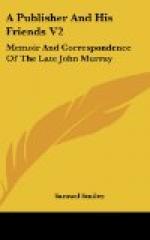renewal of correspondence
with B. Disraeli and negotiations with
him as to “Contarini Fleming: a Psychological Biography,”
1831—Moore’s “Life of Byron,” Vol. II.,
Moore’s “Thoughts on Editors,”
Thomas Carlyle recommended to him by Lord Jeffrey,
“Sartor Resartus”—which he ultimately declines to publish,
1832—Complete edition of Byron’s works,
correspondence with Benjamin Disraeli about “Gallomania,”
1834—Dean of Westminster refuses his request that Thorwaldsen’s
statue of Byron should be placed in Westminster Abbey,
1836—The first Handbook to the Continent (Holland, Belgium, and
North Germany), published,
1837—Letter to Morning Chronicle on Napier’s “History of the
Peninsular War,”
1838—Mr. Gladstone’s “Church and State,”
T. Powell Buxton’s “Slave Trade and its Remedy,”
Handbook to Switzerland,
1839—Handbook to Norway, Sweden, and Denmark,
1840—Mrs. Jameson and her “Guide to the Picture Galleries of
London,”
Handbook to the East,
George Borrow,
Borrow’s “Gypsies of Spain,”
Southey’s death,
1841—Bishop of Llandaff and “Lord Dudley’s Letters,”
correspondence with John Colquhoun on “The Moor and the Loch,”
1842—Handbook to Italy,
letters from George Borrow,
“The Bible in Spain” published,
Horace
Horace Twiss’s “Life of Lord Eldon,”
his illness, 1843—In constant communication with Sir Robert Peel,
many of whose speeches, etc., he published,
Richard Ford’s Handbook of Spain,
Mr. Gladstone on the Copyright Bill,
his failing health and death,
his dinner-parties an institution,
tokens of respect from all parts—extracts from letters
of sympathy from the Americans, Dr. Robinson and Mrs.
L.H. Sigourney,
Murray, III., John, a reader for the press at six years
old,
recollections of Scott and Byron at Albemarle Street,
present at the destruction of Byron’s Memoirs,
letter from R.W. Hay on the anonymous attack on Gifford’s
memory,
present at the Theatrical Fund Dinner in Edinburgh when
Scott declared himself the author of the “Waverley Novels,”
the originator and author of the “Guides,”
extract from his article in Murray’s Magazine on the
“Handbooks,”
him as to “Contarini Fleming: a Psychological Biography,”
1831—Moore’s “Life of Byron,” Vol. II.,
Moore’s “Thoughts on Editors,”
Thomas Carlyle recommended to him by Lord Jeffrey,
“Sartor Resartus”—which he ultimately declines to publish,
1832—Complete edition of Byron’s works,
correspondence with Benjamin Disraeli about “Gallomania,”
1834—Dean of Westminster refuses his request that Thorwaldsen’s
statue of Byron should be placed in Westminster Abbey,
1836—The first Handbook to the Continent (Holland, Belgium, and
North Germany), published,
1837—Letter to Morning Chronicle on Napier’s “History of the
Peninsular War,”
1838—Mr. Gladstone’s “Church and State,”
T. Powell Buxton’s “Slave Trade and its Remedy,”
Handbook to Switzerland,
1839—Handbook to Norway, Sweden, and Denmark,
1840—Mrs. Jameson and her “Guide to the Picture Galleries of
London,”
Handbook to the East,
George Borrow,
Borrow’s “Gypsies of Spain,”
Southey’s death,
1841—Bishop of Llandaff and “Lord Dudley’s Letters,”
correspondence with John Colquhoun on “The Moor and the Loch,”
1842—Handbook to Italy,
letters from George Borrow,
“The Bible in Spain” published,
Horace
Horace Twiss’s “Life of Lord Eldon,”
his illness, 1843—In constant communication with Sir Robert Peel,
many of whose speeches, etc., he published,
Richard Ford’s Handbook of Spain,
Mr. Gladstone on the Copyright Bill,
his failing health and death,
his dinner-parties an institution,
tokens of respect from all parts—extracts from letters
of sympathy from the Americans, Dr. Robinson and Mrs.
L.H. Sigourney,
Murray, III., John, a reader for the press at six years
old,
recollections of Scott and Byron at Albemarle Street,
present at the destruction of Byron’s Memoirs,
letter from R.W. Hay on the anonymous attack on Gifford’s
memory,
present at the Theatrical Fund Dinner in Edinburgh when
Scott declared himself the author of the “Waverley Novels,”
the originator and author of the “Guides,”
extract from his article in Murray’s Magazine on the
“Handbooks,”
Napier, Macvey,
Napier, Col. W., “History of the Peninsular
War,”
at Strathfieldsaye with Duke of Wellington,
negotiations with Murray,
Napoleon Buonaparte, escapes from Elba,
private correspondence with crowned heads,
etc., of
Europe declined by Murray,
Nelson, Lord, anecdote of,
Newton (the artist),
Nugent’s “Memorials of Hampden,”
Oliver & Boyd,
Orloff, Count,
Ouseley, Sir Gore,
Owen, Robert,
his “New View of Society,”




